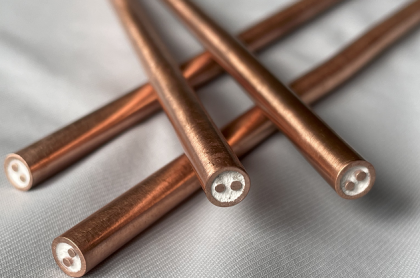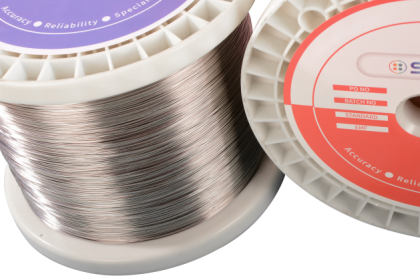In industrial applications, the choose of thermocouple should first be based on the upper limit of the measured temperature, the correct choice of thermocouple thermal electrode and protection tube; according to the structure and installation characteristics of the object to be measured, select correct thermocouple specifications and size.
The following factors need to be taken into account when selecting a thermocouple:
1. Upper limit of the measured temperature range
The most commonly bare thermocouple wire are type K , E,N,Jand T. the temperature range of K is-40°C~ +1100°C; E is - 40°C to +800°C; T is -40°C~ +350°C.
The thermoelectric potential of type E thermocouple wire is the largest,the linear relationship between thermoelectric potential and temperature is theworst;
The linear relationship between potential and temperature is the best for type K thermocouple wire;
When selecting different thermocouples, it should be referred to.
The selection of thermocouple should first be based on the upper limit of the measured temperature range
For the correct selection, it is necessary to know what the temperature measurement range of the thermocouple is. Because There are many graduation numbers for thermocouples, and different graduation numbers correspond to different
2. Required response time
The response time is expressed in terms of a time constant, defined as the time required for the sensor to change between the initial and final values in the controlled environment 63.2 % of the time required.
Grounded thermocouple has the fastest response rate. The smaller the diameter of the probe, the faster the response speed, but its maximum allowable measurement temperature is also lower.
When a thermocouple with a large time constant is used to measure or control the temperature, the instrument displayed temperature fluctuates little, but the actual furnace temperature may fluctuate can be very large. In order to measure temperature accurately, thermocouple with small time constant should be selected. The time constant is inversely proportional to the heat transfer coefficient and is directly proportional to the diameter of the thermocouple hot end and the density and specific heat of the material. To reduce the time constant, in addition to increasing the heat transfer coefficient, the most effective way is to reduce the size of the thermocouple hot end as much as possible.
3. Thermocouple connection point types
A thermocouple extension wire is a pair of specialized wires with the same temperature and electromagnetic frequency characteristics as the thermocouple it is connected to, rather than ordinary wires. When the connection is suitable, the extension wire transfers the reference end connection point from the thermocouple to the other end of the wire, which is usually located in the controlled environment.
Thegroundedtype thermocouple connection point is physically connected to the probesheath (welded), which can achieve good heat transfer thatheat is transferred from the outside to the thermocouple connection point through the probesheath. It is recommended to usegroundedtype thermocouple to measure the temperature of static or flowing corrosive gases and liquids, as well as some high-pressure applications.For insulated thermocouple, the connection point is separated from the probesheath and surrounded by a soft powder. Although the response speed of insulated thermocouple is slower thangrounded type thermocouple, they can provide electrical insulation. It is recommended to use insulated thermocouple to measure corrosive environments, which can ideally be completely electrically insulated from the surrounding environment through a sheath shield. Exposed end thermocouple allow the top of the connection point to penetrate into the surrounding environment, providing the best response time, but are limited to use in non corrosive, non hazardous, and non pressurized applications.
4. Chemical resistance
Due to the thermal inertia of thermocouple, the indicated value of the instrument lags behind the changes in the measured temperature, resulting in measurement lag. This effect is particularly prominent when conducting rapid measurements. Therefore, thermocouple with thinner thermoelectric electrodes and smaller protective tube diameters should be used as much as possible (if the temperature measurement environment permits, protective tubes can even be removed). In use, materials with good thermal conductivity are usually used, and protective sleeves with thin pipe walls and small inner diameters are used. In more precise temperature measurements, bare wire thermocouple without protective sleeves are used, but thermocouple are prone to damage and should be corrected and replaced in a timely manner.
5. Resistance to wear or vibration
Some harsh working conditions, such as high temperatures in some areas of the cement production process line, and there are flowing objects washing away thermocouple. In this case, the requirements for thermocouple are relatively high. This requires that the thermocouple and sheath materials should be both wear-resistant and have good seismic resistance. It is also important to explain this when selecting the type.
6. Structure
According to the different structures of thermocouple, they can generally be divided into3 types:Assembly thermcouple,Mineral insulated thermocouple, and thin film thermocouple.Wires of ordinary type are covered with heat-resistant insulation sleeves (such as ceramic beads) and installed in protective tubes of ceramicor metal;MI thermocouple combines thermocouple wires, insulation materials, and metal tubes to form a solid combination; Thin film thermocouple is a special structure made of two types of metal thin films.
Assembly thermocouple is mainly used to measure the temperature of the medium inside pipelines and equipment. The thermocouple and protective tubes selected vary depending on the temperature measurement range and environmental atmosphere. The connection forms during installation include threaded connection and flange connection.
MI thermocouple has the following advantages: due to their unique structure: miniaturization, small volume, small thermal capacity, small thermal inertia, fast response to the measured temperature, and small time constant. It is a fine overall combination structure with good mechanical performance,sturdy, anti vibration and impact resistance, great flexibility, and can be bent into various shapes, which is suitable for objects with complex structures (such as narrow and curved places), and can directly measure the temperature of liquids, vapors, media, and solid surfaces in various production processes from 0°C to 1800°C.
Thin film thermocouple has a small and thin measuring end and a small heat capacity, allowingit to be for the measurement of temperatures over small areas and transient surface temperatures.











 IPv6 network supported
IPv6 network supported